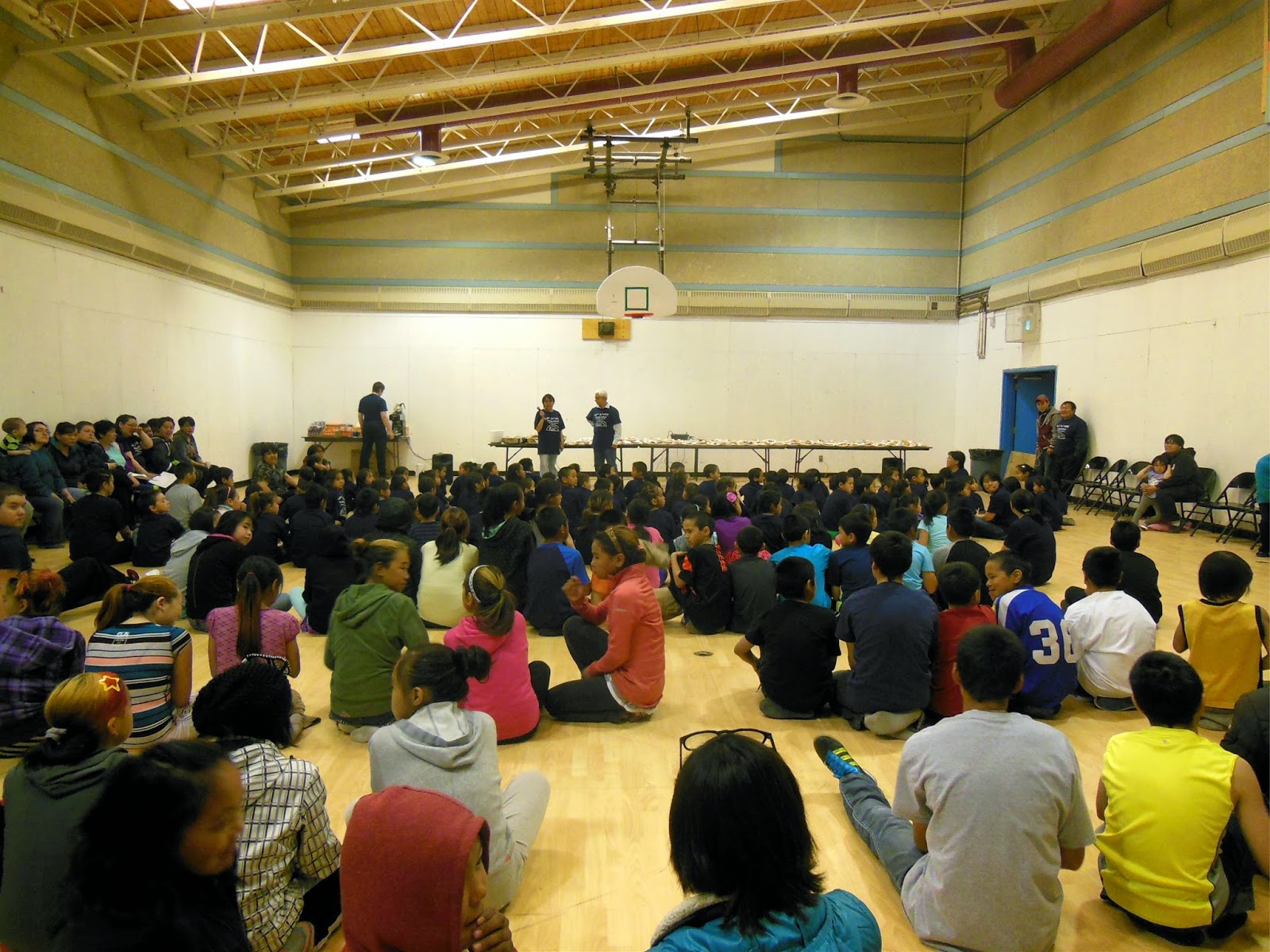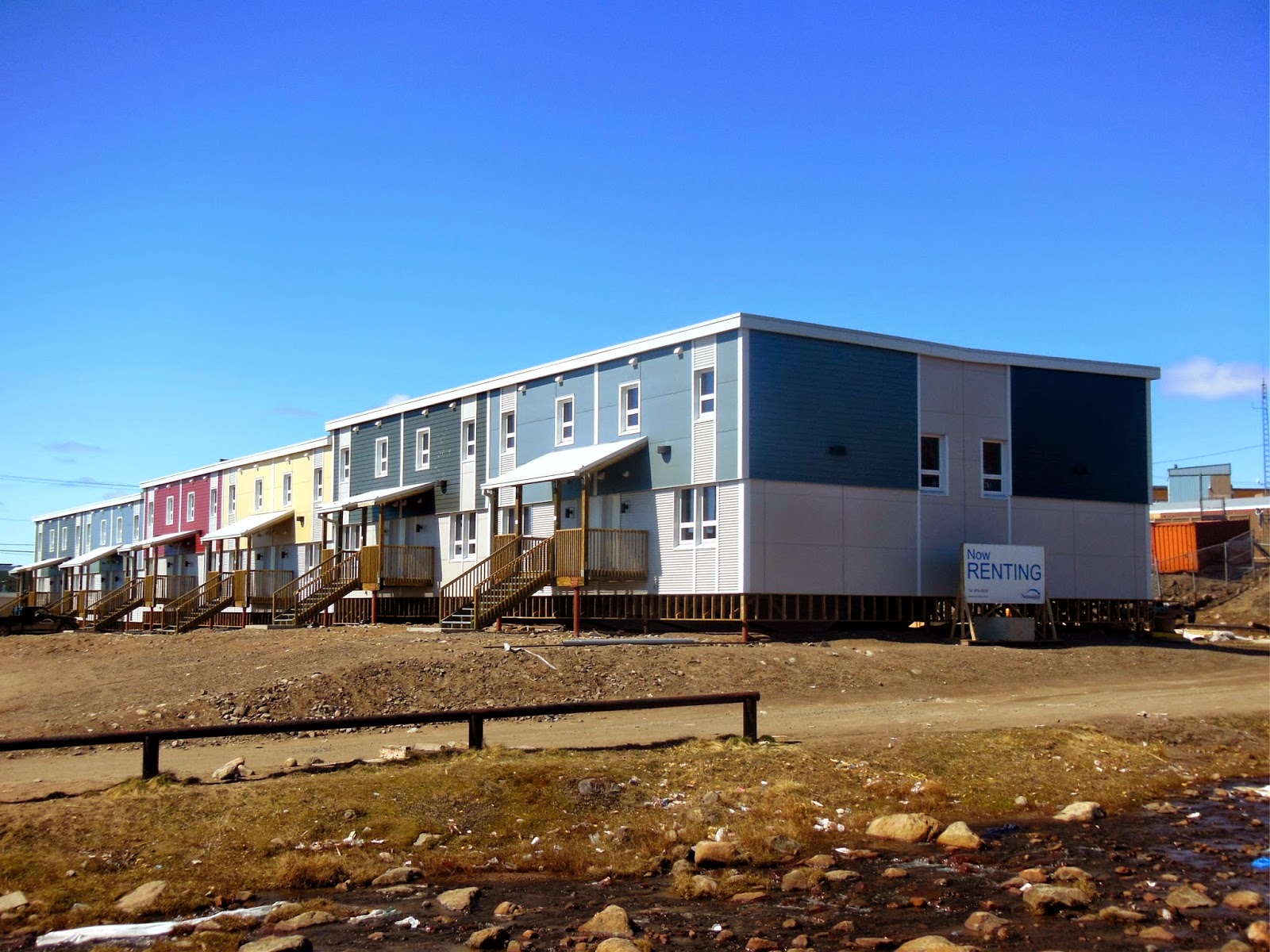The
First Air jet plane I boarded in Ottawa had been halved to accommodate the
cockpit & cargo at the front, and passengers in the rear. My assumption that the airline only did this
with their turboprop fleet was instantly disproven. Upon landing in Iqaluit, I had enough time to
walk over to Yummy Shawarma for lunch before catching my flight to Arctic
Bay. I had to get my shawarma fix because
the next time would be in December.
Several familiar faces accompanied me on the three-hour flight to Arctic
Bay. There were a few elders, and a
teacher with her common-law spouse. I
listened to music and occasionally napped for the majority of the flight. As the plane began its final approach, the
land beneath us became recognizable, transitioning from roving hills to jagged
mountains, cliffs, and canyons. The
water was dark blue & flat.
 |
| Victor Bay. |
I
greeted Frank, the former mayor of Arctic Bay, who was waiting for me in the
terminal building. After exchanging
greetings, we went outside and loaded my luggage into the back of his pickup
truck. As he drove me to my apartment,
we discussed our summer vacations, and how the upcoming training year for the
cadets of 3045 Army would look like. I
spent the next two hours unpacking and organizing my apartment.
In
the four days after my arrival and before the beginning of school, I shopped
for groceries, organized my classroom, prepped lessons, met familiar and new
teachers, greeted former students, and attended staff meetings. Several local Inuit residents greeted me at
the Northern Store & Co-op, welcoming me back to town, and saying they
heard me on the radio and saw me on tv.
I replied that I was glad that the final product turned out alright
because I never got to hear nor see it.
The
first day of school was Wednesday, August 13.
The Inuujaq School staff set up the gym and assisted the breakfast
coordinator with preparing the food for the community breakfast feast. The feast began at 9:30, with an opening
prayer by an elder. The gym was packed
with students, teachers, parents, and community leaders. After the principal's address, the teachers
introduced themselves and briefly explained what classes they would be teaching. We then proceeded to hand out the many
prepared plates of food to students and guests.
The breakfast menu consisted of grilled cheese, oranges, grapes, cheese,
and hard-boiled eggs.
I
walked around the gym, snapping photographs of people eating. A few people stopped me to ask how I enjoyed
my trip to France. I replied that it was
a fantastic learning experience. One
Inuk lady thanked me for representing Nunavut.
For
the fall semester, I would be teaching Grades 10, 11, & 12 Social Studies
(SS), and high school marching percussion.
It's a full class load without a prep period. Grade 10 SS leans more towards Inuit history,
such as, the Nunavut Land Claims Agreement and Residential Schools. There are also modules on government,
citizenship, and rights & responsibilities.
The Grade 11 SS course branches out into the world, looking at
Industrialization, Nationalism & the First World War, Global Regionalism,
and Quality of Life, just to name a few.
I began the semester with the Industrialization unit so that my students
will have a better understanding of the causes of the First World War. I'll be showing plenty of pictures from my
trip to France then. Grade 12 SS continues
to look at the world in the 20th century, with modules focusing on politics,
economics, the Second World War, and the Cold War. On top of that, my students are required to
complete a Social Studies Project, an independent study that replaces the departmental
exam.
 |
| Two of my drum students practice their basic rudiments. |
 |
| Me instructing one of my students. |
I
began the high school marching percussion program last year as a way of putting
my years of drumming to good use. I
learned marching percussion in cadets during the summers I spent at camp and really
enjoyed it. During this time, I also played
orchestral & band percussion for youth and community groups. My program is a combination of military and
DCI styles of drumming. Even though I do
not have experience performing in DCI bands, I have been instructed by people
who have, and I rely on them for valuable advice and pointers. The Band-Aid Grant I received from MusiCounts in March enabled me to purchase more drums and accessories, expanding my
program to include 8 students in total.
I also acquired four new guitars for next semester and a digital
piano.
As
the new academic year got under way, I was surprised to see and hear a pair of
CH-147F Chinook helicopters heading towards the airport to refuel on August 15th. The Chinooks were recently purchased by the
Canadian government to serve as medium-lift transport helicopters for the
Canadian military - an excellent choice!
The reason for my surprise is that the entire helicopter fleet is based
in CFB Petawawa, Ontario, slightly over 3,000km to the southeast. The word on the skidoo trail was that they
were being flown in the arctic for cold weather testing. I even heard they flew all the way to CFS Alert! Looking at the face of Canada on
Google Earth, I can only assume the helicopters had to fly to Manitoba first
and then up into Nunavut, stopping at several communities to refuel. (I would see them coming back on August
29th).
The
CCGS Des Groseilliers, a T1200 medium icebreaker vessel, visited the community
on August 17th. The ship is operated by
the Canadian Coast Guard and was commissioned in 1982. It sails Canada's arctic waters during the
summer months to escort commercial ships and serve as a primary search &
rescue unit. Last year, the staff of
Inuujaq School were given a tour of the large ship, but unfortunately, there
wasn't any time for a tour this year.
The ship left two days later, but returned on August 25th to assist with
the arrival of a VIP.
 |
| Everyone gathers at the pier. |
Prime
Minister (PM) Stephen Harper's annual tour of the north took place between
August 21 & 26. He visited the following
communities spread across the three territories: Whitehorse, Fort Smith,
Cambridge Bay, Pond Inlet, and Iqaluit.
A brief visit & photo op with the school children of Arctic Bay was
added to his itinerary at the last minute for reasons I'm still trying to piece
together. One possible theory running
around is that it was to make up for something that happened in Pond Inlet.
 |
| PM Harper arrives. |
On
the morning of the 25th, Innujaq School staff, teachers, and students made
their way down to the pier in front of the Northern Store to await the arrival
of the PM. Harper's press corps was
already there as well as his two of his bodyguards who were easy to notice (there were
wearing visible earpieces). What I &
the other southern teachers found amusing was that several reporters were
wearing heavy winter jackets with their hoods up. Their bodies hadn't fully acclimatized to the
August weather.
 |
| A. Salam, Principal of Inuujaq School greets PM Harper. |
Harper
arrived from the CCGS Des Groseilliers on a Zodiac boat just as the students were
organized into a collective mass. He
stopped and posed for pictures with several crew members from the ship before
greeting the awaiting crowd of onlookers.
MP Leona Aglukkaq was also in attendance. The principal of Inuujaq School greeted the
prime minister and gave him a school yearbook and pen as gifts. After exchanging a few words, PM Harper posed
for pictures with the school children. Philip Kalluk, the mayor of Arctic Bay, was also in attendance to greet the prime minister. After shaking his hand, Philip presented a carving to Harper made by a local carver. Several pictures were taken by excited onlookers. PM Harper briefly spoke with individual students, teachers, and local Inuit,
before being led to an awaiting car. He
waved to the crowd and thanked them for coming out to meet him. The RCMP cleared a path and the convoy of
vehicles left for the airport. A
Hercules military transport plane was waiting to take Harper and his entourage
to Iqaluit. The entire visit lasted 10
minutes.
 |
| PM Harper speaks to an excited Inuk woman. |
It
would have been more beneficial for the people of the north if more time had
been scheduled into the Prime Minister's itinerary. Visiting many communities is nice but when
it's only for a few hours or minutes, it doesn't leave a good impression. Assigning two or three days per community is
better because it gives residents the opportunity to voice their concerns &
problems to the person in charge of the nation, and hopefully, with their help,
work out possible solutions.
 |
| PM Harper gets into a black vehicle that will take him to the airport. |






























